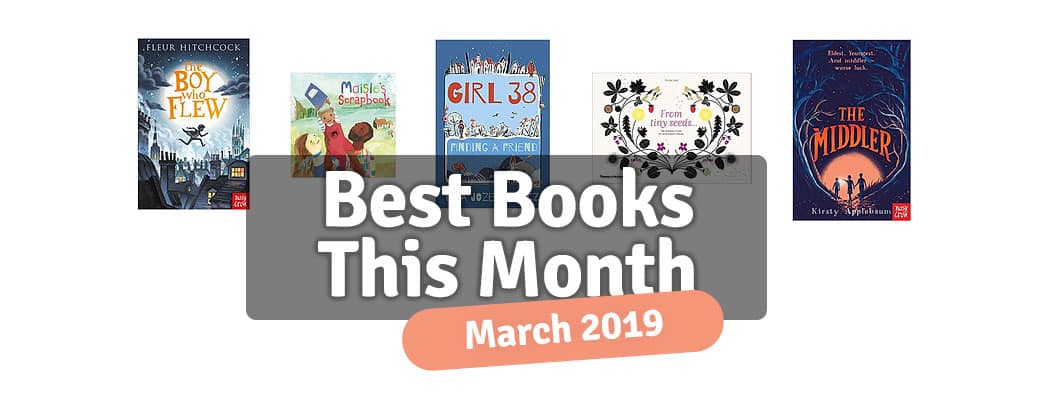It’s easy to feel lost in the flood of so many new children’s books available. Each month, we pick five of our recently published favourites.
Check out our Review Panel’s top picks for you to read in March 2019…


It’s easy to feel lost in the flood of so many new children’s books available. Each month, we pick five of our recently published favourites.
Check out our Review Panel’s top picks for you to read in March 2019…
Quirky, chilling and atmospheric, ‘The Boy Who Flew’ is a brand new offering from Fleur Hitchcock, author of the popular Murder in Midwinter. This is a gem of a story – with its roller-coaster adventure plot that will have readers gripped from start to finish and wide-eyed with curiosity to the very last page.
Athan Wilde befriends an inventor called Mr Chen, who shares with Athan his madcap ideas for flying machines. Athan has always dreamed of being able to fly and now, with a competition to build the first flying machine on the horizon, flight seems to be on everybody’s mind. As a result, there are people lurking around who will stop at nothing to get their hands on the competition prize.
But when Mr Chen is unexpectedly murdered, it falls to Athan to rescue the flying machine blueprints before they fall into the wrong hands. What follows is a fast-unfolding mystery with exciting and unexpected twists, played out with a curious cast of characters (including a very dark villain) and an enjoyably pacey narrative.
This is highly recommendable to KS2 readers who enjoy stories with plenty of intrigue, thrilling plot lines and cleverly imagined worlds.
As a fan of Ewa Josefkowicz’s debut The Mystery of the Colour Thief published last year (see our review here), I was pleased to hear about the arrival of her new newest story. This one shares a number of themes with the first book – friendship, bullying, finding courage to do the right thing and valuing the stories and experiences of other people – but this time weaves in a new thread of World War II history into the mix.
Kat is a young teenager who uses her spare time to create comic strip stories based on her fictional superhero ‘Girl 38′. At school, things become tricky for Kat with friendship issues. Meanwhile at home she strikes up a friendship with her elderly neighbour, Ania, and begins to learn about Ania’s experiences of growing up in Poland during World War II. Kat listens intently to each instalment of Ania’s story, from the time soldiers forced her to separate from her family and leave her village to the time she hid in a bakery near to where her best friend was being held in a concentration camp. As Ania’s powerful history unfolds, Kat feels challenged to find courage of her own to stand up for what is right and confront Gem’s bullying behaviour.
The three strands of Kat’s story, the Girl 38 plot and Ania’s tale weave together beautifully and mirror each other in a way that demonstrates how valuing the stories and experiences of others can enrich our own lives. With convincingly drawn characters, relatable issues and important values at its heart, this is a thoroughly enjoyable read that would suit readers transitioning from Upper KS2 to Lower KS3.
This is a unique non-fiction book exploring the wonderfully varied ways that plants spread their seeds.
With each section dedicated to different types of seed journeys, from explosions to hitchhikers to bouncers, this is the kind of book that makes you stop and think about just how amazing our natural world is.
Ten different seed dispersal methods are covered, each one explained through a wonderfully visual story of its process. Some of the dispersal methods will be familiar to children and they may recognise their own part in the process too, such as blowing dandelion seeds. Other methods will capture children’s interest and amusement, such as the seeds being digested by birds and animals (many young readers will no doubt enjoy the images of the berries passing through animal digestive tracks and returning to the ground in droppings). Some of the methods are rarer, such as the water lily seeds floating along in the water until its fruit rots and the seeds sink to the bottom. The images are striking and explain each step of the process clearly, with the seeds retaining centre position each time as the stars if the show.
This delightful non-fiction book with a storytelling feel and stylised images has something to offer readers at different stages throughout the primary age range.
I was hooked from the start by this deeply atmospheric story that is hard to put down and even harder to stop thinking about after you finish reading.
Set in a dystopian near-future, The Middler is a story all about different types of boundaries and discovering which ones are important to protect and which ones are crying out to be broken through.
Middle-child Maggie’s life in the town of Fennis Wick is governed by rules and systems, with only ‘eldests’ given value and voice and anyone from outside the town’s boundaries seen as a ‘dirty, dangerous’, deceitful’ wanderer. As Maggie’s older brother Jed prepares to be sent to camp as a hero, a privilege reserved only for eldests, Maggie begins to call into question everything she has ever known, especially after a rare encounter with a wanderer girl near the town’s boundary.
Told through the powerful voice of middle-child Maggie, this is a truly wonderful narrative that will resonate with many young readers today.


© BooksForTopics 2015-2024
review
Year group(s) the book is most suitable for:
Year group(s) the book is most suitable for:
Does the book contain anything that teachers would wish to know about before recommending in class (strong language, sensitive topics etc.)?
Does the book contain anything that teachers would wish to know about before recommending in class (strong language, sensitive topics etc.)?
Would you recommend the book for use in primary schools?
yes
Curriculum links (if relevant)
Curriculum links (if relevant)
Any other comments
Any other comments